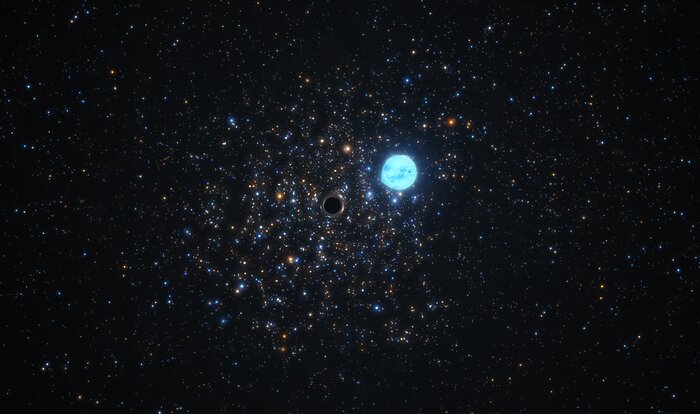Black hole found hiding in star cluster outside our galaxy

The method used by the researchers could allow astronomers to find many more black holes and help unlock their mysteries
An IEEC researcher at the Institute of Cosmos Sciences of the Universitat de Barcelona (ICCUB) is part of the team
A group of astronomers have discovered a small black hole outside the Milky Way by looking at how it influences the motion of a star in its close vicinity. This detection method, used for the first time to reveal the presence of a black hole outside our galaxy, could be key to unveiling hidden black holes in our galaxy and nearby ones, and to help shed light on how these mysterious objects form and evolve. The observations were made using the Very Large Telescope (VLT) of the European Southern Observatory (ESO), located in the Chilean Atacama Desert. The research has been accepted for publication in the journal Monthly Notices of the Royal Astronomical Society.
The black hole was spotted in a cluster of thousands of stars roughly 160,000 light-years away in the Large Magellanic Cloud, a neighbour galaxy of the Milky Way. This first black hole tracked down by the team — led by Sara Saracino, researcher from the Astrophysics Research Institute of the Liverpool John Moores University (UK) —, turned out to be roughly 11 times as massive as our Sun.
“Every single detection we make will be important for our future understanding of stellar clusters and the black holes in them,” says Mark Gieles, co-author of the study and researcher of the Institute of Space Studies of Catalonia (IEEC — Institut d’Estudis Espacials de Catalunya) at the Institute of Cosmos Sciences of the Universitat de Barcelona (ICCUB). Prof. Gieles studies the dynamics of stars and black holes in dense stellar systems. In his research he looks for ways to find black holes in star clusters through their effect on the motions of the stars.

This image shows a cluster of thousands of stars roughly 160,000 light-years away in the Large
Magellanic Cloud. The reddish filaments surrounding the cluster, made of vast clouds of hydrogen,
are believed to be the remnants of supernova explosions / ESO, NASA/ESA/M. Romaniello.
“We are looking at every single star in this cluster with a magnifying glass trying to find some evidence for the presence of black holes but without seeing them directly”, says Dr. Saracino. The black hole discovered now might be the tip of the iceberg. “We are well on our way to discovering many others, in different clusters”, she adds.
It is the first time a black hole has been found in a young cluster of stars —the cluster is only around 100 million years old, a blink of an eye on astronomical scales—. By comparing them with larger, more mature black holes in older clusters, astronomers would be able to understand how these objects grow by feeding on stars or merging with other black holes. Furthermore, charting the demographics of black holes in star clusters improves our understanding of the origin of gravitational wave sources.
To carry out their search, the team used data collected over two years with the Multi Unit Spectroscopic Explorer (MUSE) mounted at the telescope VLT. MUSE allowed the researchers to observe very crowded areas, like the innermost regions of stellar clusters, analysing the light of every single star in the vicinity: it made it possible to get information about thousands of stars in one shot, at least 10 times more than with any other instrument.
ESO’s Extremely Large Telescope (ELT) in Chile, which will start operating later this decade, will allow astronomers to find even more hidden black holes.
Press release made in collaboration with ICCUB Communication Office.
More information
This research is presented in a paper entitled “A black hole detected in the young massive LMC cluster NGC 1850”, by S. Saracino, M. Gieles, et al., accepted to be published in the journal Monthly Notices of the Royal Astronomical Society.
The Institute of Space Studies of Catalonia (IEEC — Institut d’Estudis Espacials de Catalunya) promotes and coordinates space research and technology development in Catalonia for the benefit of society. IEEC fosters collaborations both locally and worldwide and is an efficient agent of knowledge, innovation and technology transfer. As a result of 25 years of high-quality research, done in collaboration with major international organisations, IEEC ranks among the best international research centers, focusing on areas such as: astrophysics, cosmology, planetary science, and Earth Observation. IEEC’s engineering division develops instrumentation for ground- and space-based projects, and has extensive experience in working with private or public organisations from the aerospace and other innovation sectors.
IEEC is a private non-profit foundation, governed by a Board of Trustees composed of Generalitat de Catalunya and four other institutions that each have a research unit, which together constitute the core of IEEC R&D activity: the University of Barcelona (UB) with the research unit ICCUB — Institute of Cosmos Sciences; the Autonomous University of Barcelona (UAB) with the research unit CERES — Center of Space Studies and Research; the Polytechnic University of Catalonia (UPC) with the research unit CTE — Research Group in Space Sciences and Technologies; the Spanish Research Council (CSIC) with the research unit ICE — Institute of Space Sciences. IEEC is a CERCA (Centres de Recerca de Catalunya) center.
Contacts
IEEC Communication Office
Barcelona, Spain
Ana Montaner and Sònia Bagudanch
E-mail: comunicacio@ieec.cat
Lead Researcher in IEEC
Barcelona, Spain
Mark Gieles
Institute of Cosmos Sciences of the Universitat de Barcelona (ICCUB)
Institut d’Estudis Espacials de Catalunya (IEEC)
E-mail: mgieles@ieec.cat, mgieles@icc.ub.edu
